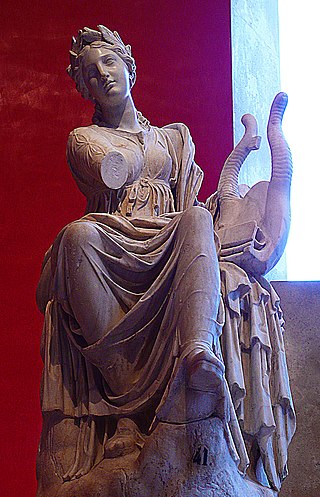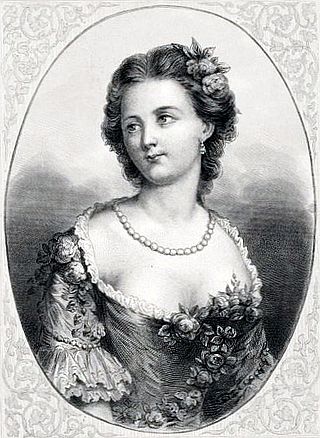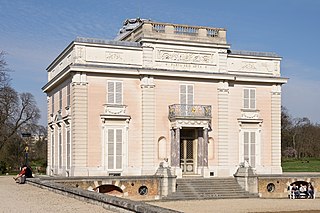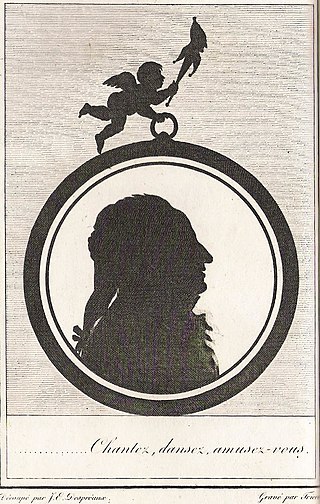Related Research Articles

In Greek mythology, Terpsichore is one of the nine Muses and goddess of dance and chorus. She lends her name to the word "terpsichorean", which means "of or relating to dance".

Marguerite Germaine Marie Donnadieu, known as Marguerite Duras, was a French novelist, playwright, screenwriter, essayist, and experimental filmmaker. Her script for the film Hiroshima mon amour (1959) earned her a nomination for Best Original Screenplay at the Academy Awards.

Delphine Claire Beltiane Seyrig was a Lebanese-born French actress and film director. She came to prominence in Alain Resnais's 1961 film Last Year at Marienbad, and later acted in films by Chantal Akerman, Luis Buñuel, Marguerite Duras, Ulrike Ottinger, Francois Truffaut, and Fred Zinneman. She directed three films, including the documentary Sois belle et tais-toi (1981).

Louis François Joseph de Bourbon or Louis François II, Prince of Conti, was the last Prince of Conti, scion of a cadet branch of the House of Bourbon, whose senior branches ruled France until 1848.

Marie-Madeleine Guimard was a French ballerina who dominated the Parisian stage during the reign of Louis XVI. For twenty-five years she was the star of the Paris Opera. She made herself even more famous by her love affairs, especially by her long liaison with the Prince of Soubise. According to Edmond de Goncourt, when d'Alembert was asked why dancers like La Guimard made such prodigious fortunes, when singers did not, he responded, "It is a necessary consequence of the laws of motion".

Henri Desmarets was a French composer of the Baroque period primarily known for his stage works, although he also composed sacred music as well as secular cantatas, songs and instrumental works.

Marie Anne de Cupis de Camargo, sometimes known simply as La Camargo, was a French dancer. The first woman to execute the entrechat quatre, Camargo was also allegedly responsible for two innovations in ballet as she was one of the first dancers to wear slippers instead of heeled shoes, and, while there is no evidence that she was the first woman to wear the short calf-length ballet skirt, the now standardized ballet tights she did help to popularize these. She is said to have been as strong as the male dancers.

Marie-Denise Villers was a French painter who specialized in portraits.

Charles de Rohan, 4th Prince of Soubise, Prince of Soubise, Duke of Rohan-Rohan, Seigneur of Roberval, and Marshal of France from 1758, was a soldier, and minister to kings Louis XV and Louis XVI. He was the last male of his branch of the House of Rohan, and was great-grandfather to the Duke of Enghien, executed by Napoleon in 1804. Styled Prince d'Epinoy at birth, he became the Prince of Soubise after 1749.

François-Joseph Bélanger was a French architect and decorator working in the Neoclassic style.

Jean-Étienne Despréaux was a French ballet dancer, choreographer, composer, singer and playwright.

The rue Joubert is a street in the 9th arrondissement of Paris, France.
The Hôtel Guimard was a private home located at 9 rue de la Chaussée-d'Antin in Paris, France. Commissioned by the Opera dancer Marie-Madeleine Guimard, it was designed by the architect Claude-Nicolas Ledoux in the neoclassical style, then built from 1770 to 1773. It is noted for having boasted its own 500-seat theater. The building was ultimately demolished as part of the massive urban renewal program headed by Baron Haussmann, which largely reshaped the city during the Second French Empire.

Louis César de La Baume Le Blanc, duc de Vaujours, duc de La Vallière, was a French nobleman, bibliophile and military man. The present duc d'Uzès and duc de Luynes descend from him.

Catherine-Rosalie Gerard Duthé (1748–1830), alternately Duthe or Du The, was a celebrated French courtesan. A companion of French kings and European nobility, she has been called "the first officially recorded dumb blonde." Duthé was a frequently requested subject for portraits, including partial and full nudes, many of which still exist in museums and private collections.
Ismène et Isménias, ou La fête de Jupiter is an opera by the French composer Jean-Benjamin de La Borde, first performed on 13 June 1763 at the Château de Choisy in the presence of King Louis XV and his wife. It takes the form of a tragédie lyrique in three acts. The librettist is Pierre Laujon.

Julie Talma, born Louise-Julie Careau, was a French dancer at the Paris Opera who became a courtesan in the years before the French Revolution. She had three sons by three different fathers. She used the gifts from her protectors to make a small fortune in real estate speculation. She married the well-known tragic actor François-Joseph Talma a few days before giving birth to twin sons. Her husband was unfaithful and ruined her. They separated and eventually divorced. Julie Talma was charming, intelligent, strong-willed, rational and a firm republican. She held an influential salon before and during the revolution and at the start of Napoleon's rise to power, and became a close friend of Benjamin Constant. Their lengthy correspondence has been preserved.

Marie Charlotte Blanc was a German socialite and businesswoman. She was a prominent member of high society in Monaco and France. After the death of her husband, François Blanc, she operated the Monte Carlo Casino.
Marie-Jeanne Larrivée, born Marie-Jeanne Lemière was a French soprano.
References
- 1 2 3 Blanc 1997, pp. 105–118.
- ↑ "anne victoire dervieux – Ballet". ballet.blogberth.com. 16 September 2018. Retrieved 11 October 2018.
- 1 2 3 4 5 6 Goodman & Norberg 2007, p. 98.
- ↑ de Laborde, Jean-Benjamin. "Zénis et Almasie". operabaroque.fr (in French). Retrieved 11 October 2018.
- ↑ Jenkins 2010.
- 1 2 Eerdmans, Emily Evans (25 July 2010). "The House that Pleasure Built". Emily Evans Eerdmans. Retrieved 11 October 2018.
- 1 2 3 "DERVIEUX Anne Victoire (1752-1829)". www.appl-lachaise.net (in French). 21 January 2011. Retrieved 11 October 2018.
- ↑ Baxter & Martin 2017, p. 111.
- ↑ de Duras 1801.
Bibliography
- Baxter, Denise Amy; Martin, Meredith S. (2017). Architectural Space in Eighteenth-Century Europe: Constructing Identities and Interiors. Routledge. ISBN 9781351576079.
- Blanc, Olivier (1997). Les libertines: Plaisir et liberté au temps des lumières (in French). Perrin. ISBN 9782262011826.
- de Duras, Louise-Charlotte (1801). "Prison Life During The French Revolution". Prison Journals During the French Revolution by Duras. Translated by Carey, Martha Ward. Project Gutenberg.
- Goodman, Dena; Norberg, Kathryn (2007). Furnishing the Eighteenth Century: What Furniture Can Tell Us about the European and American Past. Taylor & Francis. ISBN 9780415949538.
- Jenkins, Jessica Kerwin (2010). Encyclopedia of the Exquisite: An Anecdotal History of Elegant Delights. Knopf Doubleday Publishing Group. ISBN 9780385533652.